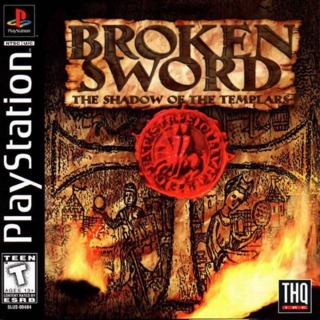A universally beloved adventure game that fails to live up to the hype.
"Shadow of the Templars" begins with a bit of a rope-a-dope as the player is introduced to a female lead named Nico Collard, who will only last as the game's protagonist through the prologue. A reporter, Nico has just witnessed a murder while investigating a story for her paper. As she does a bit of sleuthing, she realizes that this crime is only the first of a series of odd killings. The game soon opens up and Nico realizes that her ties to the deaths may be deeper than she could have ever guessed and that the crime itself cannot be solved single-handedly. In fact, it will take a bumbling tourist, George Stobbart, to take the reigns as the game's lead to solve the complex mysteries that await.
The game is not unlike most point-and-click adventures and that is both good and bad. The gameplay is familiar and simple and works without a hitch. George travels the world to a number of locales and speaks with strangers and solves puzzles over the course of approximately 10 hours, which is a bit above average for the genre. The difficulty of the puzzles varies slightly, but more often than not, will prove to be self-explanatory and be limited to items found or manipulated within a scene itself. The addition of hotspots to the Director's Cut, while likely helpful to newcomers, nearly dumb downs the approach to the level of patronization.
The story itself is deeply rooted in conspiracy, history, violence, and a realistic tone, all adjectives rarely found in the comedic or fantastic settings typically found in adventure games. The game is designed for adults and requires a careful reading of dialogue and demands a long attention span. Those players that approach the story too casually are bound to be confused by the complexity of the narrative. Thankfully, a journal is updated automatically to recap progression and serve as a refresher.
Aside from the simplicity of many of the puzzles, the biggest failing of "Shadow of the Templars" is the character writing. To many, this may be an appalling perspective, but Nico and especially George are simply bland and unenjoyable personalities to spend time with for such a long duration. The voice acting for George is terrible and often done with very poor recordings. He is designed as a humorous character, but in actuality, he is corny and can test one's patience. He is Indiana Jones if Indiana Jones was your embarrassing dad. Nico is a bit more tolerable as her dark backstory really draws the player in, but her sassiness and strained romance with George is shoehorned into a character that would otherwise have no discernable traits. As for the game's villains and side characters, they are stereotypical and forgettable.
The game was completed before 3D really grasped the industry and as a result, relied on hand drawn animation. While the settings themselves are all beautiful and fun to visit, the cut scenes can be hit or miss. They are nicely animated, but at times are so short that it becomes confusing as to whether it was being cut prematurely. In addition to often awkward animation, the added sequences found in the Director's cut were of a completely different art style, changing from hand drawn to cell shading reminiscent of a graphic novel.
I am still interested in playing through the "Broken Sword" series and understand that they are supposed to be quality games through and through, a fifth even on the way due to a successful Kickstarter campaign. Still, with boring protagonists, simple puzzles, and a story that at times is overly complex, my enthusiasm for doing so has more than waned a little.

